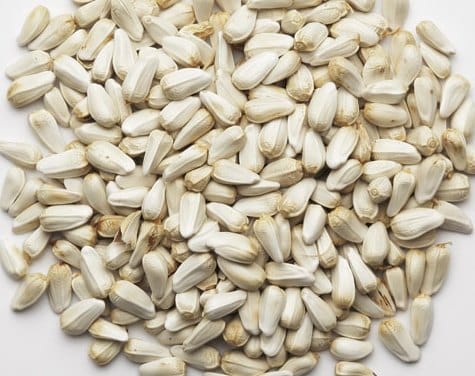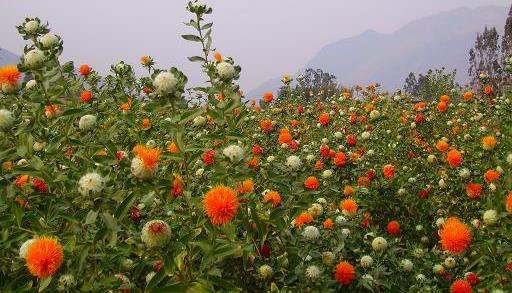Safflower Farming Guide:
Introduction of Safflower Farming:- Safflower is a highly branched, herbaceous annual plant cultivated mainly for its seed from oil is extracted. These seeds can be used bird feed as well. Silage or feed can be prepared for livestock using this crop. As demand for safflower is going up day by day, commercial growers are showing interest for this crop. Basically, it is a commercially cultivated crop for vegetable oil (extracted from safflower seeds). This crop is a rainfed crop, however can be grown round the clock with proper irrigation facility. When it comes to plant description, these plants are 12 to 58 inches tall with globe flower head having orange, yellow and red colour flowers. Usually, each safflower plant branch will have 1 to 5 flower heads with 15 to 18 seeds (each head). Safflower is originated from Mediterranean and Middle Eastern regions. Safflower is grown on large scale (commercial production of safflower) mainly in India, USA, Mexico, China, Argentina, Russia, Pakistan Ethiopia, Australia, Italy, Spain, Portugal and Iran. Safflower oil and seeds have an excellent health benefits and even used in herbal medicines. Commercial growers can get excellent profits with safflower farming as this crop is drought resistant (to some extent) and requires less water, maintenance when compared to other oils seed crops.
Scientific Name or Botanical Name of Safflower:- Carthamus tinctorius L.
Genus of Safflower:- Carthamus.
Family Name of Safflower:- Asteraceae.
Safflower Names in Other Parts of World:- Saffemal (Sinhalese), olio di cartamo (Italian), Κνήκου λάδι (Greek), khae (Nepali), Safloori(Estonian), 홍화 오일 (Korean), Distelöl (German), Bréige Ola (Irish), 红花油 (Chinese), Shafranovo maslo (Bulgarian), Safloras (Latvian), サフラワー油 (Japanese), Ulei de șofrănel (Romanian), l’huile de carthame (French), Světlicový (Czech), сафлоровое масло (Russian), Aspir Yağı (Turkish),روغن گلرنگ در (Persian), 红花 (Taiwanese), น้ำมันดอกคำฝอย (Thai), Dầu cây rum (Vietnamese), Safflor olja (Swedish), olej szafranowy (Polish), Saflortistelolje ( Norwegian).
Top 10 Production Countries of Safflower:- The following are the top ten countries of Safflower production in the world.
- Kazakhstan
- Mexico
- India
- United States
- Russia
- Argentina
- Turkey
- China
- Uzbekistan
- Tanzania.
Safflower Names in Other Parts of World:- Saffemal (Sinhalese), olio di cartamo (Italian), Κνήκου λάδι (Greek), khae (Nepali), Safloori(Estonian), 홍화 오일 (Korean), Distelöl (German), Bréige Ola (Irish), 红花油 (Chinese), Shafranovo maslo (Bulgarian), Safloras (Latvian), サフラワー油 (Japanese), Ulei de șofrănel (Romanian), l’huile de carthame (French), Světlicový (Czech), сафлоровое масло (Russian), Aspir Yağı (Turkish),روغن گلرنگ در (Persian), 红花 (Taiwanese), น้ำมันดอกคำฝอย (Thai), Dầu cây rum (Vietnamese), Safflor olja (Swedish), olej szafranowy (Polish), Saflortistelolje ( Norwegian).
Safflower Names in India:- Kardi, Safflower, Kartamo, Kusum, (Assamese, Bengali, Oriya, and Hindi), Kusuma (Teluge), Kusumba (Tamil), Chandrukam (Malayalam) Kusumba / Kusumbha (Punjabi), Kosambi (Gujarati), Kardi (Marathi), Kusube (Kannada).
Health Benefits of Safflower:- The following are some of the health benefits of safflower oil.

- Safflower oil boosts immune system.
- Safflower oil aids in regulating menstrual periods.
- Safflower oil good for skin and hair health.
- Safflower oil aids in managing diabetes.
- Safflower oil may regulate cholesterol levels.
- Safflower oil good for heart health.
- Safflower oil good remedy against obesity
Cultivars (Varieties) of Safflower:- Well, there are many improved/hybrid varieties of Safflower are available. Find out the suitable cultivar for your region from local agriculture/horticulture/forest department. Some of the popular varieties of Safflower are Centennial, Finch, Hybrid, Morlin, Nutrasaff, Montola , Mondak Cardinal, K 1, Co 1, N-630, N-62-8, A-300, Manjira, S-144, Jsf-1, K-1, Co-1, Type-65, Carmex, S-541, Aprr-3, Bhima, Hus-305, Sharda, Jsi-7, A-2, Pbns-12, Nebraska-5, Nebraska-10, And Saffire.
Climate Requirement for Safflower Farming:- Safflower crop requires cool and dry climatic condition and sensitive to frost conditions. Heavy rain-fall areas are not preferred for safflower farming. The safflower crop thrives best in areas with warm temperatures and sunny, dry conditions during the flowering and seed-filling periods. High humid and constant rainy conditions damage the crop resulting in low seed quality and crop yield.
Soil Requirement for Safflower Farming:- Safflower crop requires fertile, well-drained and deep soils (medium to heavy soils) with high water holding capacity. Soils with high levels of salinity are not recommended for safflower farming. If the crop is grown as irrigated crop, light alluvial and loam soils are best for good yield. In case of un-irrigated crop, black cotton soils are preferred as they have excellent water holding capability. If the crop is intended for commercial safflower seed production, soil test is recommended to find the fertility.
Land Preparation in Safflower Farming:- Land should be prepared well enough for sowing the safflower seeds. With the help of local tractor or local plough, give 1 or 2 deep ploughings followed by 2 or 3 harrowing. Break the clods in between the ploughings to bring the soil to a fine tilth stage. Remove any weeds or dried branches from previous crops. Supplement the soil with 15 to 20 tonnes/ha of well-rotten farm yard manure (like cow-dung) increase the soil fertility. This organic manure should be applied in last harrowing during land preparation. If the crop is grown as mixed crop, safflower shares the manuring, tillage, and Inter-cultivation provided to the main agriculture crop.
Propagation in Safflower Farming:- Propagation of safflower crop is done through seeds.

Season for Safflower Sowing:- Usually, this is a rain-fed crop. However, under good climatic conditions and irrigation facility, this crop can be cultivated throughout the year,
Seed Rate, Spacing and Sowing in Safflower Farming:- Seed rate depends on type of crop cultivated. In case of solo (pure) crop, a seed rate of 8 to 15 kg/ha is sufficient whereas mixed crop requires a seed rate of 20 to 25 kg/ha. Spacing required between plants for rainfed safflower crop is about 45 x 15 cm and Irrigated crop is about 60 x 30 cm.
It is important to go for matured quality seeds that are free from pest damage and fungal attack. Buy these seeds only from certified seed companies to avoid fake seeds. To avoid any seed borne disease (root rot disease in the early stage), carry out the seed treatment before 24 hours of sowing with Thiram at 4 grams/kg of seed in a polythene bag and ensure a uniform coating of the fungicide over the seed. Sow the seeds in line at a depth of 3 cm and cover with soil. Seed sowing can be done by country plough or seed sowing machine.
Irrigation Schedule in Safflower Farming:- In most of the Asian countries, the safflower is grown as rain-fed crop due to its drought resistant property. In case of irrigated situation, the crop should get its first irrigation before sowing for proper germination. The next irrigation is required at flowering (30 to 40 days after sowing) and seed farming stage (60 to 70 days after sowing).
Crop Rotation and Inter-crops in Safflower Farming:- Crop rotation in safflower farming is an important task that enriches the soil and ultimately increases the crop yield. Safflower crop can be rotated with sorghum, green gram, black gram, peanut (groundnut). Safflower can be grown as mixed crop with any gram and wheat. If this is grown as intercrop, 1 to 2 rows of safflower may be altered for every 7 rows of main crop.

Manures and Fertilizers in Safflower Farming:- As mentioned in land preparation, supplementing with FYM is very useful for getting more yields. In-organic fertilizers like NPK, is also mandatory for proper crop growth. In sandy soils, apply 15-20 tonnes/ha of compost or FYM at the time of last ploughing/harrowing as mentioned in land preparation. In areas with irrigation N:P2O5:K2O of 40:40:20 kg/ha should be applied at the time of sowing. The fertilizers should be applied in furrows 8-10 cm deep and 4-5 cm away from the seed at the time of sowing.
Inter-Cultivation and Weed Control in Safflower Farming:- Inter-cultivation activities depend on type of crop (solo or mixed). Generally it requires 2 thinning after 8-10 days and 20-25 days ((Thin out the seedlings to a spacing of 15 cm between plants for better spacing) after sowing in the field. Weeds can be controlled mechanically and chemically. This crop requires 1 weeding and 2 hoeing and they should be carried out @ 2 weeks interval for removal of weeds. For more branching and flowering, cut the top of the plants at the age of 40 to 60 days.
Pests and Diseases in Safflower Farming:- Pest and disease control in Safflower plantation is very important for higher yields, quality seeds and oil.
- Pests: Gram pod borer/capsule borer, Safflower caterpillar, Safflower aphid, and Capsule fly (Safflower bud fly) are common insect pests found in Safflower farming.
- Control Measures: Pest resistant quality seeds, crop rotation and proper seed treatment will ensure the least pests attack in safflower farming. To further prevent these insect pests, follow common cultural, mechanical and biological practices.
- Diseases: Alternaria blight, Cercospora leaf spot, Head rot and wilt, Powdery mildew, Mosaic, Ramularia leaf spot, Rust, Wilt, and Root rot are main diseases found in safflower cultivation.
- Control Measures: Disease resistant quality seeds, crop rotation and proper seed treatment will ensure the least disease attack in safflower farming. To further prevent these diseases, follow common cultural, mechanical and biological practices.
Note: Your local Agriculture department is a good source for finding suitable solutions for controlling pests and diseases in safflower farming.
Harvesting in Safflower Farming:- Generally the safflower crop will be ready for cutting in 4 to 5 months after sowing. The indication of maturity is that when leaves and capsules become dry. The crop can be harvested by cutting the plants near to the ground level or uprooting the plants. It is advised to harvest in morning times when there is dew on plants. The harvested crop should be kept for couple of days to dry the capsules. The plants should be threshed with stick and winnowed for obtaining clean seeds. If the crop is intended for ‘dye’ purpose, the flower heads may be plucked @ 2 days interval after flowering.
Yield in Safflower Farming:- Well, yield depends on many factors like safflower cultivar, soil type, climatic conditions, type of crop (mixed or solo) and crop management practices. On an average, one can expect under good scenario a yield of 600 to 1000 kg/ha in case of solo crop. If the crop is grown as mixed crop, yield would be about 100 to 150 kg/ha.
Marketing of Safflower:- Commercial producers should have a well-defined marketing plan before sowing the crop. Oil seed companies are best source to sell the crop in bulk.

I am a Safflower Farmer in Africa and need to go commercial. I would like to be sure of where to market different products.
Need more information on mechanization. hat isavailable?